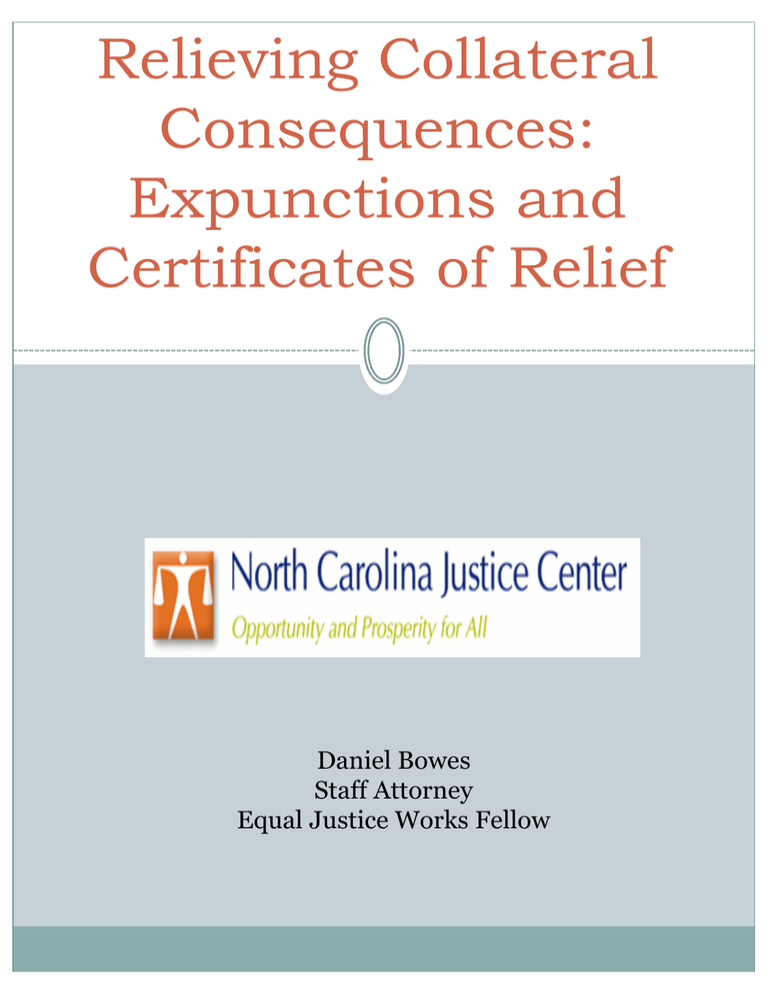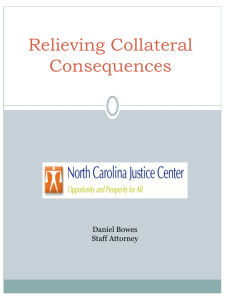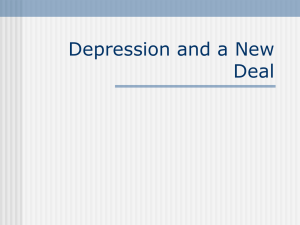
Relieving Collateral
Consequences:
Expunctions and
Certificates of Relief
Daniel Bowes
Staff Attorney
Equal Justice Works Fellow
Collateral Consequences
Explained
2 Types of Collateral Consequences
Civil Disabilities (imposed by statute)
Attach at the time of conviction
Direct (incarceration, probation, fine) v. Collateral
Imposed by hundreds of state and federal statutes
Often unknown to defendants and attorneys at plea
Impacts are severe, far-reaching, and long-lasting
Meant to protect community safety and punish
Make sense in certain limited situations
Rooted in medieval concept of “civil death”
Private Bias
Individuals with criminal records are often treated
as second class citizens
Questions of arrest and conviction asked in
applications for private employment and housing
Both types of collateral consequences serve as
barriers to reentry
Facilitate high rates of recidivism
A Sample of Collateral
Consequences in NC
“Statutes and regulations creating collateral consequences are scattered throughout the
North Carolina General Statutes and Administrative Code. Parties who need to know about
these consequences – charged and convicted individuals, attorneys, judges, and state
decision-makers – often are not fully aware of all of the potential collateral disabilities
because of this disorganization.” - Admin Law Section's Comm. on Collateral Consequences
Immigration
Housing
Hunting License
Child Custody
Foster
Child Support
Parental Rights
Workers
Compensation
Care/Adoption
Jury Duty
Occupational
License
Public Office
Financial Aid
Public Benefits
Public
Employment
Drivers License
Termination of
Unemployment
Insurance
License plate
Voting
Military Service
Firearm Permit
Impact:
Recidivism
“Although no one
supports ‘coddling
criminals,’ society has a
strong interest in
preventing recidivism.”
-Uniform Law Comm.
The three pillars of
successful
reintegration are
gainful employment,
stable housing, and
family supports.
Isolated from these
opportunities by
informal social
stigmas and
collateral
consequences,
individuals with
criminal convictions
are more likely to
recidivate.
Expungement
An expungement is the process by which a record of a criminal incident is
destroyed or sealed. It is basically as if the incident never happened.
Accordingly, f you had your only criminal conviction expunged, then you
could answer “No” when asked on an employment application whether you
have ever been convicted of a crime.
Age at
Commission
Disposition
Misdemeanor 1st
Offense Under Age 18
Dismissal or NG
Opportunities for
expungement in NC are very
limited. They are largely
refined to just two
categories- those focused on
young individuals and
dispositions that did not
result in conviction. Below
is the only outlier.
Gang offense under 18
(1st Offense)
Identity theft
Cyber bullying
DNA records
Non-violent felony
under 18
Possession of a
Controlled Substance
under 21 (1st offense)
Pardons of innocence
Misdemeanor Larceny
Older than 15 years
(no other felonies; no
misdemeanors within
15 years)
EXPUNGEMENT
Each type of
expunction has
different criteria,
filing requirements,
and costs.
Please refer to the
expunction grid
provided in your
materials for more
details.
FILING FOR
INDIGENT STATUS TO
WAIVE FEE
Where there are fees for
filing petitions to
expunge, the fees are
waivable if you obtain
indigent status. Petition
for Indigent Status is
form AOC-G-106 and can
be found here:
http://www.nccourts.o
rg/Forms/Documents/
561.pdf or in the office
of the Clerk.
CRITERIA
Need to make sure that your specific criminal record is
eligible for expunction. This means knowing:
-your criminal record
-the level of each offense
-if the offense is eligible for expunction
GETTING YOUR CRIMINAL RECORD
You may access your statewide criminal record from the SBI for $14.
The Right to Review Request Form is included in your materials. It
can also be accessed by searching the website: ncdoj.gov for: Right to
Review Packet. Or call the SBI at (919) 662-4509 ext. 6266.
FILING REQUIREMENTS
Each type of expunction has its own form that you can
access here: www.nccourts.org/Forms/FormSearch.as
or from your county’s clerk of court. See the
expunction grid for form numbers.
Be mindful that different expunctions require different
types of affidavits. For example, one type of
expunction requires that you provide an affidavit
stating that you have a diploma or GED and have
performed 100 hours of community service.
COSTS
Most applications for expunction are free, but some are
expensive. For example, expunction for 1st time
misdemeanor offense committed before Age 18./21 has
a filing fee of $125. Also be mindful that clerks usually
charge fees for a certified copy of the expunction,
which you’ll want since most other copies will be
destroyed.
Warning: The expunction process is NOT quick. It can take 5-6 months or more.
Certificates of Relief
Certificates of Relief
(NCGS §15A-173)
3 Primary Benefits:
Relieves most collateral sanctions (§15A-173.2d)
Considered favorably in disqualification decisions (§15A-173.2d)
Protects employers from negligent hiring lawsuits (§15A-173.5)
BONUS: Evidence of rehabilitation persuasive to employers,
landlords, etc.
Sanction v. Disqualification
A collateral sanction is an automatic bar to a benefit or opportunity
A collateral disqualification is statutory language which allows
another decision making group to deny an individual a benefit or
opportunity based on the conviction.
Ex. Medical Doctor/Physicians Assistant (§90-14)
Statute contains both a collateral sanction and a disqualification
Disqualification for conviction of “crime involv moral turpitude”
Sanction for “conviction of a felony”
Ex. Teacher/Principal (§115C-296)
Statute contains both a collateral sanction and disqualification
Disqualification for convictions indicating unfitness
Sanction for several specified felonies (ex. Taking indecent
liberties with a student (Class I felony)
NOT an expunction or pardon
Eligible Convictions and
Applicable Sanctions
Eligibility
1 misdemeanor or 1 Class G, H, or I felony= eligible
2 misdemeanors or Class G, H, or I felonies (convicted in same
session)= eligible
2 or more convictions in different sessions= NOT ELIGIBLE
Any Class A, B, C, D, E felony= NOT ELIGIBLE
NC Felony Classifications
Examples of G, H, and I felonies G: Felony death by vehicle, common law robbery, financial
identity fraud, trafficking in marijuana
H: larceny, possessing stolen goods, embezzlement < $100k
I: bigamy, cruelty to animals, abandonment of a child
Collateral Sanctions NOT subject to relief (NCGS §15A-173.3):
Sex offender registration (NCGS §14-208.5)
Possession of a firearm by a felon (NCGS §14-415.1)
But see Restoration of Firearm Rights (NCGS §14-415.4)
Motor vehicle license, revocation, or ineligibility (NCGS §20)
Criminal Justice Officer and Sheriffs certification (NCGS §§17C, E)
Employment as corrections or probation officer
Employment as prosecutor or investigator in NCDOJ or District
Attorneys Office
Any sanction enacted by federal law or in the NC Constitution
Procedure
WHAT WE KNOW (as of January 2012)
The petition for a certificate of relief must be made in the county in
which the conviction(s) occurred.
The Petition and Order for Certificate of Relief is form AOC-CR-273 and
can be accessed here: http://www.nccourts.org/Forms/FormSearch.asp
A district attorney may appear at the hearing
The victim of the underlying offense has the right to appear or submit a
statement for consideration in a proceeding for issuance of the
Certificate of Relief.
BUT…there is plenty we don’t know (as of January 2012)
This is a brand new process and each county has the discretion to
establish its own procedures for petitions for Certificate of Relief.
There is a distinct possibility that you may be the first person to petition
for a certificate of relief in your county.
So, be prepared for anything.
You should be prepared to appear before a judge for a hearing. Or it
might be the case that the Clerk of Court issues the order without
having a formal hearing.
I suggest that at the time you submit your petition, you submit with the
fully completed petition supporting documentation.
Supporting documentation could be:
Affidavit from petitioner explaining why granting the Certificate of Relief does not
pose an unreasonable risk to the safety or welfare of the public to any individual.
Affidavit(s) from person(s) familiar with the character and reputation of the
petitioner in the community in which he lives explaining that petitioner’s character
and reputation are good.
Affidavit from petitioner or employer of petitioner explaining the petitioner is
engaged in or seeking to engage in a lawful occupation or activity.
If there is a hearing, you should be prepared to have any person who
provided you with an affidavit to appear as a witness.
Evidentiary Standard
(what you must prove)
Petitioner must establish certain matters by a
preponderance of the evidence (more likely than not =
51%):
twelve months have passed since the person
completed his or her sentence;
the person is engaged in or is seeking to engage in a
lawful occupation or activity;
the person has no criminal charges pending;
the person has complied with all requirements of
the person’s sentence;
Granting the petition would not pose an
unreasonable risk to the safety or welfare of the
public or any individual.
Proving Reasonable Risk
Must prove: individual is not an unreasonable risk
Be prepared to do three things:
Describe your motivations for applying for the certificate of relief
Describe the circumstances in which the underlying crime was
committed
Be prepared to acknowledge the conviction and, because the court
may ask, provide details of the circumstances of the crime
Explain why, despite the past conviction, you can now be trusted
not to commit another crime.
Length of period between commission of crime and petition
• Age of the individual at the time of commission might be
relevant if the person was young (narrative of maturity)
The prison, jail, probation, parole, rehabilitation, and
employment records of the individual since the date the crime
was committed. (ex. if drugs were a factor in the commission of
the crime then completion of rehab would likely be essential; if
you obtained your GED, etc)
Nexus between the criminal conduct and the motivations for
seeking a certificate of relief (ex. prior conviction was for
bigamy and the individual is seeking certificate of relief in order
to get license to be a locksmith)
General character (comm. involvement, family support, etc)
Legal Disclaimer
The information contained in this presentation is general legal information and should not be construed as legal
advice to be applied to any specific factual situation. Any use of the presentation does not create or constitute a
solicitor-client relationship with the North Carolina Justice Center. As the law may be interpreted or applied
differently depending on your location or situation, the information provided in this presentation is not a
substitute for the advice of a lawyer.
Who is eligible for expunction and/or a certificate of
relief?
Rommel
42 years old
Convicted of Larceny
(misdemeanor) when he was
22 years old
Wants to be a Nurse
Doug
Convicted of Voluntary
Manslaughter (Class D
felony) in 1999 and
Possession of a Firearm by a
Felon (Class G felon) in
2000.
Dana
30 years old
Convicted of cruelty to
animals (Class I felony) in
2006
Wants to be a barber
Completed rehabilitation
program, volunteers at
animal shelter
Rommel
eligible for both an
expunction (misdemeanor
larceny > 15 yeas ago) and a
certificate of relief
Doug
Not eligible for expunction
Not eligible for a certificate
of relief for 2 reasons
His two felony
convictions did not occur
in the same court session
One of the felonies is a
Class D felony, which is
ineligible
Dana
Not eligible for expunction
Eligible for a certificate of
relief
Daniel Bowes
Staff Attorney
danielb@ncjustice.org
(919) 861-2061





